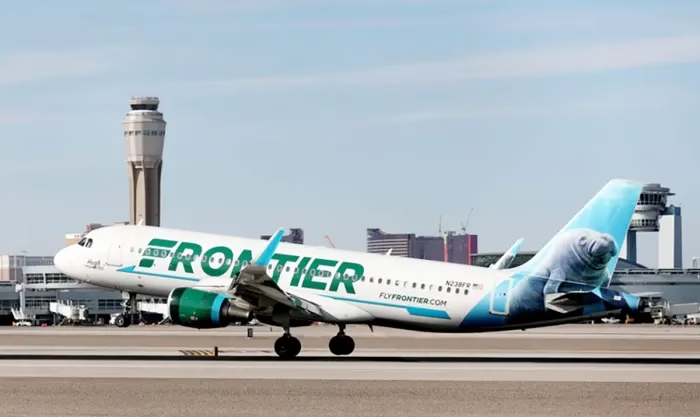Two Frontier Airlines Flight Attendants Injured Due to Severe Turbulence
**Denver, CO —** Two Frontier Airlines flight attendants were injured Wednesday after their aircraft encountered severe turbulence mid-flight, forcing an emergency diversion. The incident, which occurred on Flight 789 from Denver to Miami, has reignited discussions about passenger and crew safety during unexpected air disturbances.
### **The Incident**
Frontier Airlines Flight 789, an Airbus A321neo carrying 182 passengers and six crew members, was approximately two hours into its journey when it hit an area of extreme turbulence over the Gulf of Mexico. According to passenger accounts, the aircraft suddenly dropped without warning, sending unsecured items flying through the cabin.
“It was like hitting an invisible speed bump at 30,000 feet,” said Mark Henderson, a passenger seated near the rear of the plane. “One second everything was fine, and the next, people were screaming. I saw a flight attendant get thrown into the ceiling.”
The two injured crew members, identified as Sarah Reynolds and Javier Mendez, were serving beverages when the turbulence struck. Reynolds reportedly suffered a concussion and a fractured wrist, while Mendez sustained back injuries. Both were treated by a doctor who happened to be on board before the flight made an emergency landing in New Orleans.
### **Emergency Response**
Upon landing at Louis Armstrong New Orleans International Airport, paramedics boarded the aircraft to assist the injured attendants. Reynolds and Mendez were transported to a nearby hospital, where they were listed in stable condition.
Frontier Airlines released a statement shortly after the incident:
*“The safety of our passengers and crew is our top priority. We are deeply concerned for our injured team members and are providing them with full support. We commend our crew for their professionalism in handling this unexpected event and are cooperating fully with authorities to investigate the cause of the turbulence.”*
The Federal Aviation Administration (FAA) has launched an investigation into the incident, though preliminary reports suggest the turbulence was caused by a sudden change in weather patterns.
### **The Dangers of Turbulence**
Turbulence-related injuries are not uncommon in aviation, but severe cases—especially those causing significant harm—remain rare. According to FAA data, between 2009 and 2023, there were 163 serious turbulence injuries on U.S. airlines, with flight attendants accounting for nearly 80% of those cases.
Dr. Elaine Carter, an aviation safety expert, explained why flight attendants are particularly vulnerable:
*“Unlike passengers, flight attendants are often moving through the cabin during flights. Even when seatbelt signs are on, they may be assisting passengers or preparing for service. A sudden jolt can send them airborne before they have time to react.”*
Modern aircraft are designed to withstand extreme turbulence, but injuries occur when people or objects are not properly secured. The FAA and airlines continuously emphasize the importance of keeping seatbelts fastened, even when the seatbelt sign is off.
### **Passenger Reactions**
Passengers on Flight 789 described the experience as terrifying.
“I’ve flown for years and never felt anything like that,” said Lisa Tran, another passenger. “The plane just dropped, and then it felt like we were on a rollercoaster. I saw one of the flight attendants hit the overhead bins—it was horrifying.”
Several passengers praised the crew’s response, noting that despite their injuries, Reynolds and Mendez helped calm panicked travelers before medical assistance arrived.
### **Airline and Union Response**
The Association of Flight Attendants (AFA), the union representing Frontier’s cabin crew, issued a statement calling for improved safety measures:
*“This incident highlights the very real dangers flight attendants face every day. Airlines must ensure that protocols for turbulence are strictly followed, and crews should never feel pressured to perform duties when it is unsafe to do so. We will be working with Frontier to review this event and prevent future injuries.”*
Frontier Airlines has temporarily adjusted its in-flight service procedures, requiring all crew members to be seated during periods of expected turbulence. The airline is also reviewing its weather monitoring systems to better anticipate sudden changes.
### **What’s Next?**
Flight 789’s passengers were rebooked on other flights, with many expressing relief that the situation wasn’t worse. Aviation experts say that while turbulence is unpredictable, advancements in weather radar and real-time data sharing between pilots and air traffic control are helping reduce risks.
For now, Reynolds and Mendez are recovering, with colleagues and passengers alike sending well-wishes. A GoFundMe page set up by fellow crew members has already raised over $15,000 to assist with medical expenses.
As investigations continue, one thing remains clear: turbulence remains one of the most unpredictable hazards in aviation, and both passengers and crew must remain vigilant—even when the skies appear calm.
—
